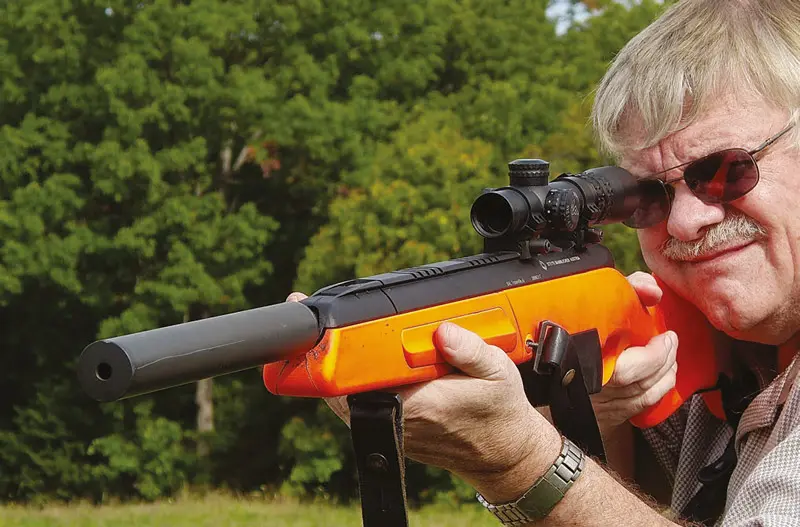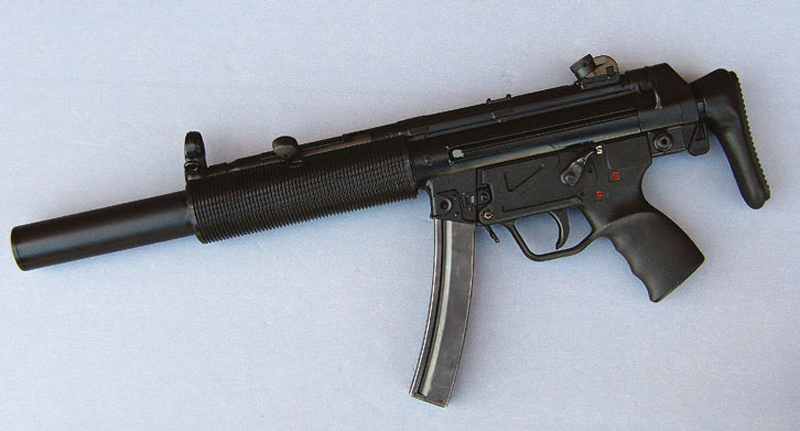I recently received the Paladin Press publication Tactical Use of Low-Signature Weapons for Military and Police by Mark White. I’d like to review and comment on some points from the book.
This book should be viewed as a short overview that can be read in an evening. Some chapters are only a couple of pages long. For those with substantial knowledge about suppressors, there won’t be much new data, but for those without a lot of knowledge, it will give you what you need to understand how suppressors work and how they can best be utilized.
One thing I did learn early in this book is about the MACH Disc, the shield-shaped mass of gas that leaves the muzzle at a high rate of speed (for a typical 5.56x45mm round fired from an M16). Understanding the MACH Disc is a great aid in understanding how muzzle brakes and suppressors work, and their advantages and disadvantages.
In his chapter on muzzle brakes, White explains how in a sophisticated KAC muzzle brake, the flash is virtually eliminated, but the MACH Disc is broken up and expelled to the sides. This increases the sound heard by the shooter— to the extent that permanent damage can be done to hearing without ear protection—but cutting sound heard downrange by two to three times. That’s the type of data that can be gleaned from even a couple of pages.

The first few chapters of the book explain how suppressors work. Useful to the novice and those with some experience of suppressors is the chapter entitled Suppressible Weapons Types. This gives an overview of which weapons lend themselves best to use of suppressors. White points out that the M16/ M4/AR-15 can be relatively easily suppressed because of its direct gas impingement operating system. Designs such as the AK, which vent their gases directly into the atmosphere, are harder to suppress.
A few chapters cover ammunition for suppressed weapons. I found the section on subsonic rifle bullets interesting and informative. White makes the point that subsonic rifle bullets travel through the air more efficiently than supersonic bullets. As a result, a streamlined .30 subsonic bullet, though it leaves the muzzle at a lower velocity, only loses about 100 feet-per-second (fps) at 300 yards—I didn’t know that!
Subsonic bullets generally penetrate better. I did know something about that from my Russian contacts who have used the 9x39mm AS “Val” suppressed assault rifle, which uses a 250-grain bullet.
White also has a chapter on the best velocity for a subsonic bullet—950 fps. That is almost exactly the muzzle velocity of the “Val.” One other point made by White is that rifles intended for use with suppressors and subsonic ammunition should have a faster twist—he recommends 1:9 for a 7.62x51mm NATO rifle.
Other chapters include Flash-Hider and Suppressor Attachment (for versatility, White recommends the Yankee Hill Machine flash hider that takes a suppressor with quick-release attachment), Short-Barreled Rifles, Barrel Length Recommendations in .308 and .338, Barrel Stiffness and Accuracy, and Suppressor Size and Material (wherein he notes that a rifle that may be used with and without a suppressor should be sighted in both ways).
In his chapter on Integral Suppressors and the previous one on Perceived Threat to Civilians and Combatants, White makes a good point for police tactical units. An integrally suppressed weapon in the hands of a tactical marksman will be less likely to unsettle civilians and help counter the “Ninja-clad urban assault troops” fear. On the battlefield, an operator with an obviously suppressed weapon may be more likely to attract enemy fire, so there is a military advantage as well.
The final chapter and the longest is titled Supersonic Systems and discusses calibers from 5.56x45mm NATO to the 20x102mm. Although White does not discuss them in detail as related to suppression, he does give a good evaluation of their effectiveness from a military point of view in the recent combat environments of Iraq and Afghanistan.
I recommend Tactical Use of Low- Signature Weapons for Military and Police especially as an introduction to suppressors or one reference book for those who want a basic source. I believe all of the books on suppressors in my reference library have been published by Paladin Press, which has been a leader in books on this topic.
Some of their earlier titles are out of print, but for readers wanting a much more definitive reference, I recommend Silencer History and Performance, Volumes I and II, which are still in print. Volume I is by Alan C. Paulson, while Volume II is by Paulson with N.R. Parker and Peter G. Kokalis. Normally, I find any information I seek on suppressors in these volumes. A useful feature for anyone considering purchasing a suppressor is a section that evaluates most of the suppressors currently available.

SMG among special ops and counterterrorist units. Because of their mission and
pistol caliber, SMGs are one of the weapons most frequently suppressed.
I have not yet had a chance to read one other Paladin title that has just been published. The Art and Science of Wet Suppressors was written by Klaus Rompanen. Debating the pros and cons of wet versus dry suppressors is beyond the scope of this column, but I understand from contacts who are more knowledgeable than I that the current generation of dry suppressors makes the wet suppressor less necessary. However, I may be wrong and Rompanen may convince me otherwise when I read the book.
Although I am most often interested in the applications of suppressors for military special operators, snipers and tactical law enforcement officers, today an ever-growing number of private citizens are purchasing suppressors. Here in Missouri where I live, suppressors became legal a few years ago and have been selling very well ever since.
In many parts of the world, it is considered entirely logical to use a suppressed .22 rifle or pistol to eliminate garden pests or hunt small game without bothering neighbors. When I was in Finland, I found it interesting that buyers of pistols are strongly encouraged to purchase a suppressor as well, so they can shoot without creating noise pollution.
Whatever your reason for purchasing a suppressor, these books from Paladin Press will make you much more informed about how the suppressor works, how to maintain it, and which one to choose.





